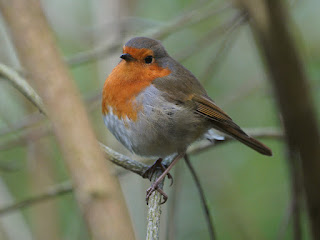A single Goldfinch twittered in a treetop beside the Long Water. It's puzzling that there are so few Goldfinches in the park when they are a common sight in the surrounding streets. There are plenty of trees with edible seeds, such as alders, as well as teasels and other source of suitable food.
But there is no shortage of Long-Tailed Tits, which feed mainly on insects. One flock was going round the Long Water ...
... and another round the Serpentine.
The confident female Coal Tit in the Flower Walk followed me along the path, coming down to take one pine nut after another. Her mate watched from the bushes. I think it won't be long before he decides it's safe to take food from people's hands.
A Robin is also on the brink of coming over.
There are several colonies of Wrens around the lake. Recent mild winters have allowed the smallest birds to survive, and numbers of Wrens and Goldcrests are increasing noticeably.
The female Peregrine was on the barracks.
The Green Woodpecker on Buck Hill was calling and could be seen in a lime tree.
A pair of Black-Headed Gulls called and displayed to each other on the edge of the Serpentine.
Only two Cormorants remained on the Long Water. This one at Peter Pan stared at the camera ...
... and gave an enormous yawn. You often see birds yawning, but whether it's because they are bored or sleepy I don't know.
An unusually dark Great Crested Grebe was fishing at the Lido. I think they may get darker as they get older.
These are the two rabbits at the Henry Moore sculpture. The younger one, shown first, has a torn right ear. The older one has a cataract in its left eye.
To brighten up a dim day, a fine picture by Mark Williams of a pair of Mute Swans courting on the Serpentine.











It always shocks me that moody bruisers such as male swans turn out to be so romantic and devoted with their family.
ReplyDeleteLovely picture of the Long Tailed Tit. Adorable little borb (another word I learned in reddit: a a portmanteu of bird + orb, round little bird).
Now I wonder if there are subspecies in Grebes.
Yes, there are subspecies of Great Crested Grebe, but these are geographically distributed. The Eurasian nominate species is Podiceps cristatus cristatus and there is an African subspecies P.c. infuscatus and an Australasian one P.c. australis. I think the latter two are both smaller and darker than our local ones. Although grebes are not great flyers they have managed to spread all over the Old World by virtue of being able to live at sea.
DeleteLovely image of the Mute Swans. There was a similar image behind the weather girl on the local news last night when she said it was a great Valentine's image.
ReplyDeleteInteresting how often you see Goldcrests. I've still only seen 4 this year-one locally & 3 on the Walpole Park monthly bird walk in Ealing.
I was lucky to see one of the Firecrests in Pembroke Lodge gardens, Richmond Park yesterday as well as a pair of Ravens passing over, which have become fairly regular around the park in recent months.
I've only seen a Firecrest in the park once, and that was years ago. There was one singing more recently in the greenhouse enclosure, which I heard but it wouldn't come into view.
Delete